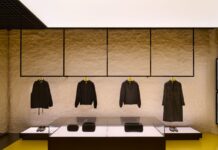Over the last five to 10 years we’ve all witnessed the changing face of the retail store. The early signs were evident; Abercrombie and Fitch, with its dimly lit and beautifully curated ‘theatres’, staffed by model-esque sales associates and the likes of Apple with its sparsely filled, brightly lit showcase stores, where if you need anything other than trying or touching one of their products, you take a ticket and join a virtual queue.
More recently, I visited the Dyson Demo Store on Oxford Street where, in addition to being able to experience the deadly suction power of their cord-free Vacuums by selecting from an array of familiar spillable substances, you can experience the ‘difference the Dyson Supersonic hair dryer can make’ to your hair by booking an appointment with an in-store stylist for wet or dry styling. Unfortunately, as anyone who knows me will contest, a service I unfortunately no longer require.
These stores are more about experience and brand engagement, and less about the transaction. If I can buy a Tesla in around seven clicks online, in the long term, is there any need for a showroom or a car sales person?
So, why is the retail experience changing? Has this change been forced by consumer demands? The millennials who don’t necessarily need to test drive a car before buying one? Or is this re-purposing of the store happening because wily e-commerce and website directors have sat in boardrooms and trading day meetings championing their ability to remove things like rent, lighting and even store staff from their cost-of-sale? If people are being encouraged to transact online, then what do retailers do with their physical presence? Probably a combination of the two!
We know that ‘traditional’ stores are closing down, including high profile locations like Ralph Lauren’s Fifth Avenue flagship. We know they are limited by a geographical footprint and the inconvenience of opening hours when compared to their digital channel counterparts. We also know, that for your high-ticket items like jewellery, complex items like electronics or products that take some consideration in their purchase like furniture, sporting equipment, musical instruments and the like, you’re more likely to purchase in-store with the support of a trained ‘human’ product expert than if you were on their website.
Live chat companies spotted the value of the human in the sales process, though in the end it seems that the human is being more and more phased out by bots in that field and, to be honest, if I have a simple question about compatibility or delivery times, do I really need an offshore human being sat in a call centre tapping away with the answer? Probably not.
Let’s now focus in on the products that really need human consultation: jewellery, furniture, sporting goods, musical instruments, drones and cars for example. Depending on the product or service you offer, there is clearly still value in having both a digital and a physical channel. Where I believe the opportunity lies is in blending these two channels, or perhaps more so taking the better elements from each channel and sharing them with the other; take one of the most valuable sales assets a retailer has – their in-store product experts, and make them available in the furthest reaching channel.
How about manning the physical store 24 hours a day to deal with the digital channel? And, rather than a call centre, why not transport the web customer into the physical store using an immersive video stream with two-way audio? The retailer has already spent huge volumes of money on creating their theatre. Now it doesn’t matter where in the world it is based, and physical opening hours can be a thing of the past.
So, back to Tesla. You can do the whole purchase process online, but they’ve invested heavily in their physical presence, including high street-style stores where customers cannot test-drive or transact. They have well thought out, premium-location spaces manned by knowledgeable experts. I learned that they can, ‘pretty much’ drive autonomously now. Whilst our cars might end up driving themselves, there is still clear value in a human-driven retail experience for considered purchases.















